
It’s never been harder to figure out how to dress for work. A generation ago, the average office uniform was simple: a dark suit worn with a white shirt, dark tie, and pair of leather dress shoes. If you were in London, those shoes were black; if you were in the US or Continental Europe, they may have been brown. Self-expression those days was limited to the pattern on your tie.
Today, things are different. Ostensibly, men can wear whatever they want to work thanks to decades of “casual Fridays.” At the same time, just because HR departments no longer regulate what we wear, that doesn’t mean most of us don’t feel social pressure to dress according to softly coded norms. In most offices, that means polos with khaki chinos, or perhaps t-shirts with jeans. Not as interesting as casualwear could be; not as sharp as the traditional coat-and-tie. It’s just vanilla bland.
So, if you care about how you dress, you probably find yourself in a bind. What do you wear if your office doesn’t do suits, but you also don’t like the typical business casual uniform?
There’s no easy answer, partly because there’s no such thing generic office (and thus, no generic worker). Dressing well requires a bit of situational awareness, and everyone has different needs. So, I thought I’d lay out eight suggestions for how to do business casual – moving from the most formal to the least. The idea is how you can dress a little sharper and feel good about yourself, without breaking out a three-piece. Hopefully there’s something in here that works for you.
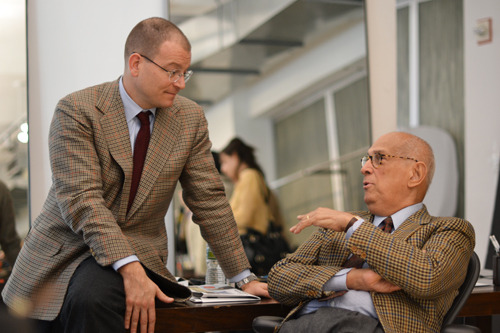
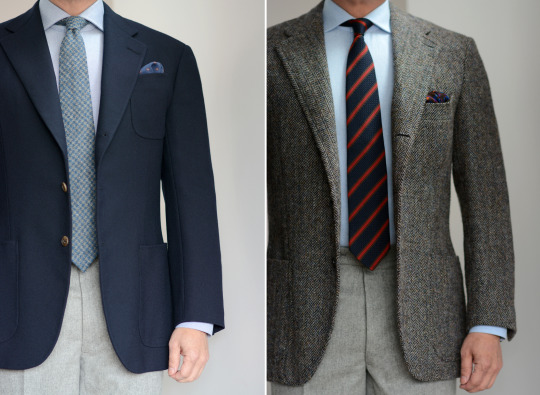
THE TRADITIONAL COAT-AND-TIE LOOK
Most offices today don’t require suits, but a good number will allow sport coats with ties. If you’ve been reading this blog for a while, you’re probably familiar with the basics. Certain details will make a jacket look more casual, even to people who aren’t necessarily acquainted with these things. Think: a softer shoulder line, patterned fabric, or patch pockets. See our guide on how to read formality in tailored clothing.
Navy sport coats here will be your workhorses. They have a professional sensibility, recalling the days with the color signified something about “city dress.” Gray jackets can also work, but they’re less versatile than those in brown. That’s because most of your trousers should be light- to mid-shades of gray, making it hard to pair the two. (Don’t try to build a trouser wardrobe without gray pants; it’s a bad idea).
Charcoal trousers can also be good if you have light-colored jackets, but they’re otherwise hard to wear (same goes for navy, which will look a little more modern than dark gray). On the other hand, tan is very useful, particularly in cotton or wool.
For shirts, stick to a foundation of whites and light blues. Stripes and checks can be OK, so long as they’re simple. Remember these will serve as the background for your tie, and the more complicated the shirt, the more likely you’ll walk out the door with a clashing combination.
Ties are often best in dark colors, such as navy, chocolate brown, and burgundy. I particularly like grenadines and simple rep stripes. The second is an all-American look; the first allows you to add visual interest to solid-colored jackets, but also not clash with anything patterned.
Finally, and perhaps most importantly, consider picking up a few pairs of dark brown derbies. Too many men go for tan as their second pair of shoes, but they’re considerably harder to wear. Dark brown, on the other hand, goes with everything, and derbies play better with sport coats given their slightly more informal nature (as compared to oxfords). I particularly like Norwegian split toes, but you can also choose wingtips, cap toes, or plain toes.
(photos above via Men in this Town and Voxsartoria)
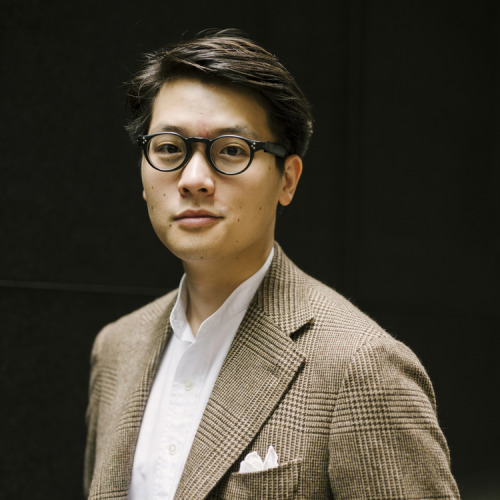
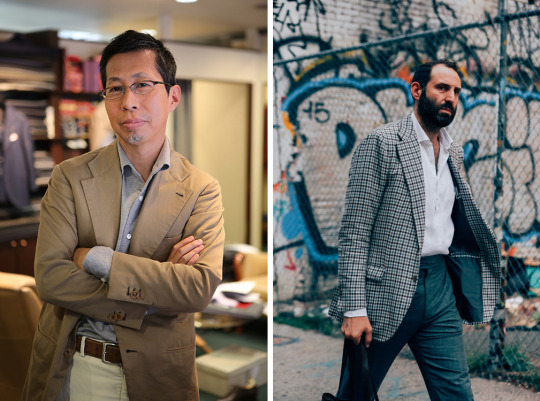
SPORT COATS WITHOUT A TIE
If you, like me, work in a more casual office, you may be wondering how you can wear a sport coat without seeming too stiff. The answer is easy: ditch the tie. An open collar conveys a certain kind of ease that even the most casual tie won’t.
Once you lose the tie, all sorts of shirt options become available. It’s easier to wear busier shirts, such as wider butcher stripes, or even dark colors (although, please never wear black dress shirts unless you’re DJ-ing a high-school prom). For something even more casual, consider dressier chambrays or long-sleeved polos. I particularly like this washed denim shirt I bought last year from Proper Cloth, an advertiser on this site. It’s sold out at the moment, but they bring it back every now and again.
Same with the section above, you’ll want to review our guide on how to read formality in tailored clothing. And if you’re going to work without a tie, sport coats in the most casual materials will probably be fine as well.
Also worth noting: while it’s perfectly acceptable to wear a sport coat without a tie, you should never wear a tie without a tailored jacket. That is, unless you work in a cell phone store.
(photos via Mark Cho, Coccinella, and GQ)


SWAPPING IN CASUAL PANTS
It can be trickier to dress things down further from here, but entirely possible if you pay attention to certain principles.
The most obvious solution is to swap our your gray flannel trousers for some blue jeans – the modern symbol of casualwear. The trick is to get the right combination. Most men make the mistake of wearing suit jackets with denim (don’t do this). Instead, pick a more casual sport coat and a dressier pair of jeans. This makes it easier to bridge the gap in formality
For jackets, consider more casual fabrics: tweed, cotton, or corduroy. Navy hopsack also works, simply because it’s an old American look at this point. Just choose navy jackets with more texture (again, stay away from smoother, silkier wools that make you look like you’re wearing an orphaned suit jacket).
For jeans, stay with dark denim, ideally built with a slightly higher rise. I really like this pair from Drake’s, which has a slim, slightly tapered leg line. Our friends Gus and David, both excellent at this denim-on-tailoring thing, also wear various models from Levi’s.
Alternatively, you can get a dressier pair of chinos. Something made from a finer cotton, and doesn’t have any puckering along the side seams, will seem dressier than what you’ll find at J. Crew (and thus easier to wear with sport coats). The downside: dressier chinos are expensive. If you can stomach the prices, I like the ones from Rota and Ring Jacket.
Nine times out of ten, these combinations do better without a tie. Or frankly even a pocket square. Remember, you want to keep these as casual as possible. Ties in these cases will often look affected.
(photos above via Wired and P. Johnson Tailors)
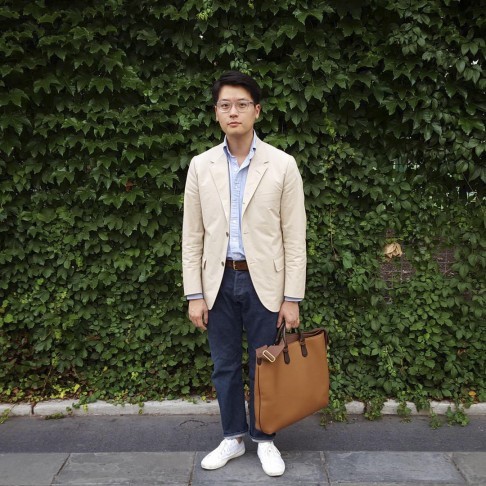

SNEAKERS WITH TAILORING
To dress things down even further, swap out your traditional shoes for sneakers. Plain, simple designs, such as Common Projects Achilles (a more affordable version available at our advertiser Gustin) or Supergas (particularly the plainer 1705s), are good. Leave chunkier, more colorful sport sneakers at home.
Much like jeans, you’ll have a better chance of knocking this out the park when everything else in your outfit is a little more casual. That means: softer sport coats, no tie, and casual pants. See Mark Cho from The Armoury above in his jeans, or George Wang of BRIO in his chinos. Change either of these out for gray flannel trousers and the incongruity can be jarring.
One downside to this look: sneakers often work best when they’re clean, not ratty (the opposite of casualwear, where beat-up sneakers have a certain charm). If you need a good cleaner, I recommend Jason Markk. The stuff works wonders.
(Photo above via Mark Cho and George Wang)
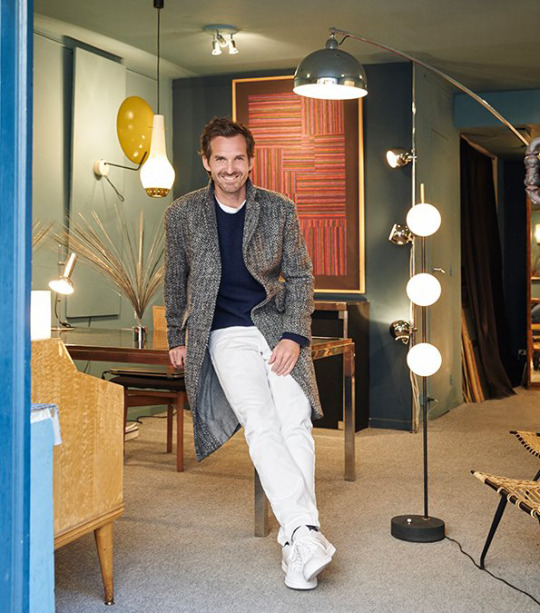
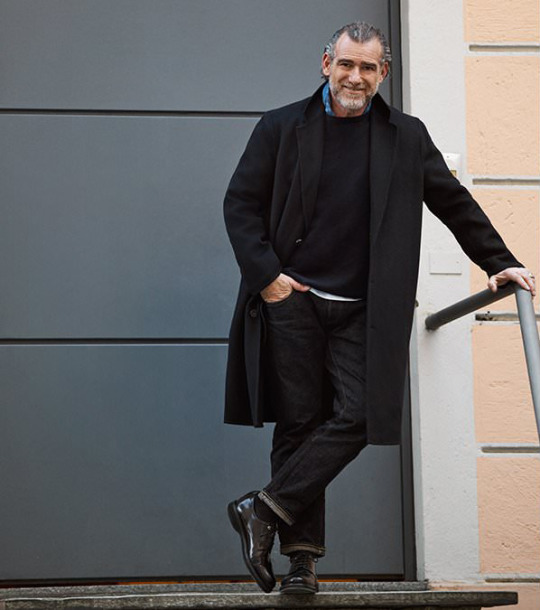
THE MODERN OVERCOAT
Here’s one of the sad realities of modern life: for some guys, it’s just hard to wear tailored clothing, no matter how casual the jacket. Sad because tailoring flatters like nothing else. Judicious wadding can extend the shoulders, making the waist look smaller by comparison; good canvas and haircloth can build up the chest, making the wearer look more athletic. That’s not true for casualwear, which is almost always unstructured.
One way to get around this is to wear a tailored overcoat. Most overcoats have some kind of structure in the chest, and you can use it to dress up even the simplest sweater and jean combination.
There are two ways of wearing an overcoat. The first is to get something that contrasts with the rest of your outfit (e.g. a brown topcoat worn over a cream sweater and light gray pants). The other is to match colors, but play within the textures, patterns, weaves, and sheen. Alessandro Squarzi’s black wool topcoat above, for example, looks different from his black jeans simply because it’s made from different fibers. These low-contrast moves can be hard to pull off, but look great when they’re done well.
Unfortunately, most overcoats these days are short, thanks to the shrunken-fit trend. I personally think most guys look better in longer, looser-fitting coats. When sized big enough to be worn over a tailored jacket, it has a charming sense of ease when thrown over a sweater. Plus, when the coat is long, it’ll sway nicely as you walk.
(photos above via Mr. Porter)
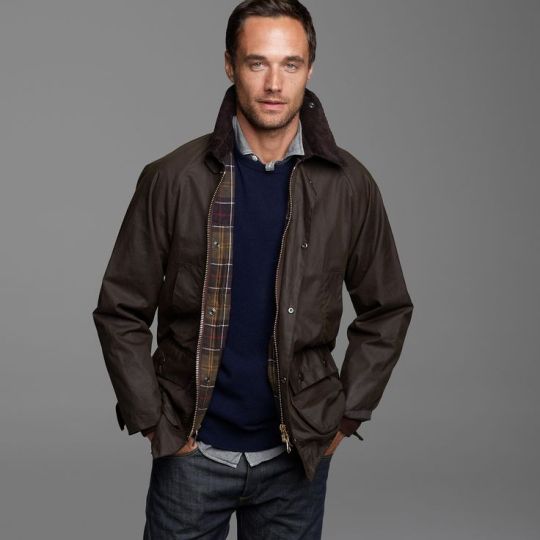
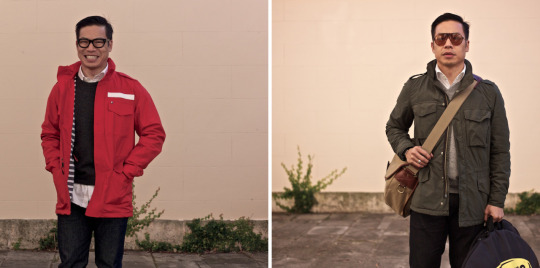
THE WIDE WORLD OF CASUALWEAR
Of course, more casual still is just casualwear. There’s no way to cover all the variations here, but even for more conservative offices, you could do well in a classic duffle coat or field jacket. Our friend Graeme in Sydney, Australia was great at this sort of “classic casualwear” look back when he was still posting.
Pete’s everyday uniform is also a good starting point – light blue OCBDs, which could double as your dress shirts when you need, worn with raw denim jeans, field jackets, and sneakers. If you need to dress it up a little, swap the sneakers out for chukkas. I particularly like chukkas in brown suede or pebble grain leather. The added texture breaks up what would otherwise be a plain expanse of leather. If you’re looking for a good guide to field jackets, we have two. If you want something a bit “dressier” than a field jacket, try a waxed cotton Barbour (we have a full Barbour buying guide here).
(photos above via J. Crew and GuidoWongolini)


BETTER KNITWEAR
At its best, the typical, modern office uniform goes something like this: a pair of well-fitted jeans, some OK shoes, a button-down shirt, and a v-neck sweater. It’s the kind of outfit your mom would be proud to see you in if you were a 12 year old boy going to church.
Plain, merino v-necks and crewnecks can look great under sport coats, but for more casual outfits, I think sweaters do better when they have a bit texture or pattern. Think: prickly Shetlands, Fair Isle knits, cabled Arans, or chunky shawl collar cardigans (which, if thick enough, can be worn in lieu of a jacket).
It’s not that plain merinos are wrong; it’s just that on their own, they’re a bit boring. Save those for when you need something to layer under tailored jackets. For all other situations, go for something with a little more personality. A chunky, interesting ribbed knit can be a great way to dress down a grey pair of wool trousers, allowing you to wearing something a little nicer than jeans without looking overly formal.
(photos above via A Kind of Guise and Mr. Porter)

WELL-FITTING BASICS
If nothing above works for you, take heart. If your clothes fit well, you can dress simply and still look great. See our friend Graeme, again, in his chinos and dress shirt.
A lot of this will be about buying the best fitting clothes you can off-the-rack, and then learning what can be altered (as most clothes have to be tweaked here and there). We have guides on how shirts and trousers should fit. Most shirts will need to have the sides slimmed up and/ or darts put into the back. Just be careful not to go too slim (we recommend employing the “sit test”). Trousers should also be hemmed to a single or no break. You can decide on whether or not you want cuffs.
You’ll also want to upgrade your shoes. Jesse has a nice post on what he calls “in-between footwear” – something better than your average pair of New Balances, but isn’t as formal as laced-up oxfords. We have guides on where you can find good, affordable shoes; how to tell quality in leather uppers; and how much you might want to consider spending. Jesse even has a video on how to take care of your purchases so that that they age well over time.
In the end, you probably won’t look as good as Graeme above (he’s a handsome dude), but you’d be surprised at how much better you’ll look in properly tailored clothing. Even if your office doesn’t allow for anything but the most vanilla-bland of clothes, there are still good kinds of vanilla.
(photo above via GuidoWongolini)